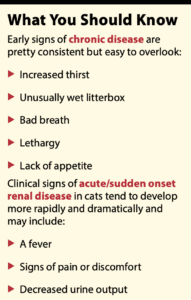Hyperthyroidism is a common endocrine disorder in aging cats. Left untreated, it can lead to myriad serious problems including heart failure, organ dysfunction, high blood pressure, and blindness. As such, cat owners should know what signs to watch for at home and schedule regular senior screening examinations at least once annually (twice annually once they reach 10 years of age).
“Clinical signs of hyperthyroidism result from excess thyroid hormone, and may include weight loss despite a good appetite, hyperactivity, increased thirst and urination, gastrointestinal upset, high blood pressure, and increased respiratory rate and effort,” says Dr. Alyssa Chandler, assistant clinical professor of small animal medicine at Cornell University College of Veterinary Medicine. “Fortunately, thyroid hormone is measured on most screening bloodwork panels recommended by your veterinarian at annual wellness visits, so this disease is usually identified and managed early before severe effects are noted.”
Treatment options for hyperthyroidism in cats include radioiodine therapy (I-131), an iodine-restricted prescription diet called y/d, or a medication called methimazole (see below). Surgical removal of the thyroid gland is another theoretical treatment option, but is rarely pursued due to the availability of these less invasive, effective therapies.
What Monitoring Entails
Regardless of which treatment option you choose, monitoring these cats carefully is of the utmost importance. Under-treatment results in ongoing symptoms and progression of the disease with all its associated badness (heart disease, hypertension, blindness, liver disease).
Over-treatment increases the risk of inducing hypothyroidism. Because the thyroid gland regulates metabolism, dropping thyroid hormone levels too low results in diminished blood flow to the kidneys, which negatively impacts kidney function. Remember, these are usually older kitties, so kidney function is already a worry in many cases.
 Obviously, monitoring appetite, attitude, and well-being at home, as well as watching for return of symptoms of hyperthyroidism, is critical to your cat’s health. Your veterinarian will monitor your cat’s weight at every visit, perform a physical examination, check blood pressure, and draw blood for a chemistry screen, complete blood count and a thyroid hormone level. Further diagnostics, including urinalysis, chest X-ray, and/or echocardiogram may be recommended based upon results of preliminary tests.
Obviously, monitoring appetite, attitude, and well-being at home, as well as watching for return of symptoms of hyperthyroidism, is critical to your cat’s health. Your veterinarian will monitor your cat’s weight at every visit, perform a physical examination, check blood pressure, and draw blood for a chemistry screen, complete blood count and a thyroid hormone level. Further diagnostics, including urinalysis, chest X-ray, and/or echocardiogram may be recommended based upon results of preliminary tests.
The treatment of choice for hyperthyroidism in cats is radioiodine therapy, mostly because it is highly effective, has few side effects, and one treatment generally lasts for life. Choosing this route means not having to medicate your cat twice a day for the rest of his life, which is fabulous for both of you.
The potential downsides are:
- The biggest expense is up front
- Your kitty must be hospitalized for several days
- You can’t visit due to radioactivity restrictions
Rarely, a cat may become hypothyroid (low thyroid hormone) after treatment. If this happens, you will end up having to medicate your cat forever after all. Luckily, this unfortunate situation is rare. Monitoring for these guys is usually recommended at 1, 3, 6, and 12 months post-treatment, then every six to 12 months for life.
Diets and Meds
Hill’s prescription diet y/d is a severely iodine-restricted diet. Iodine is necessary to produce the thyroid hormone in the body, making this food a viable treatment option for indoor-only cats. It’s not for cats who go outside, because the cat cannot eat anything else for the diet to work, including mice, chipmunks, and food left out for them by caring neighbors. It can be dangerous for a cat being treated for hyperthyroidism with y/d to eat anything else, as any extra ingested iodine can quickly result in dangerously high spikes in thyroid hormone levels. This might make managing a hyperthyroid cat with y/d diet in a multi-cat household challenging as well. Monitoring for these guys is recommended at four and eight weeks after starting the diet, then every six months for life.
Methimazole is a medication that prevents iodine from binding to thyroid hormone precursors, thereby interfering with production of thyroid hormone. It comes as a pill, liquid, or transdermal gel and is typically administered twice a day. Side effects are generally mild and usually resolve after a week or two on the medication. Occasionally, more severe side effects, including a decrease in red blood cell production, autoimmune syndromes, and extreme itchiness of the face occur, necessitating discontinuation of the drug.
“Most often, hyperthyroidism in cats is treated with methimazole,” says Dr. Chandler. “Thyroid hormone levels are monitored while the dose is adjusted to achieve the desired effect. I recommend rechecking lab work two to four weeks after a dose adjustment.”
As far as routine long-term monitoring for these guys, Dr. Chandler says, “Once your veterinarian has determined the correct dose of methimazole for your cat, they should have a physical examination, complete bloodwork with thyroid hormone, urinalysis, and blood pressure measurement every three to six months to ensure that they remain healthy and that thyroid levels are appropriately controlled.”
Hyperthyroidism is a common disease in aging cats that warrants your attention. Fortunately, it’s a straightforward diagnosis with several different treatment options. With early diagnosis, appropriate treatment, and monitoring, the prognosis is good.



